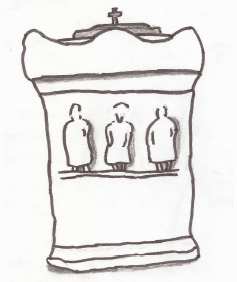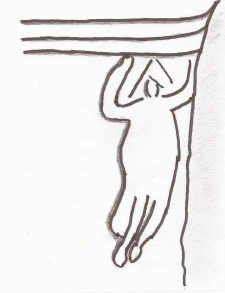Visitors to Lund St John the Evangelist Church may be surprised to see a Roman altar standing, in pride of place and still in use, inside the church. The story of what the altar was originally for and how it came to be at the church is one we’ll try to piece together.

On viewing the altar we can see that there are carvings on three of its sides. Its front has three identical figures, simply carved, wearing what looks like dresses. The two narrow sides have much more skilled but faint carvings, and seem to show three dancing women, with arms raised. The rear side has no inscription or carving on and whether it ever had any is not clear.
What are we to make of these images? There seem to be two possibilities. The Historic England Pastscape website gives a reference to the 1933 The Antiquaries Journal which states that the altar was dedicated to ‘The Mothers’. These are Romano-British goddesses, or more correctly a single goddess but displayed in triple form. The goddess was originally a Celtic one associated with fertility and prosperity that continued to be worshipped in Roman times. A large and much more elaborate carving was found in Ancaster, Lincolnshire (see the reference section below to read more about it).
Closer to home, there are two altars dedicated to the Mother goddesses and both were found in Ribchester. In contrast to the Lund one, they have no figures on but do have inscriptions. The first has been known since the time of the antiquarian William Camden who visited Ribchester in 1580. The altar was taken from Ribchester and moved to Dinckley Hall and from there to Stonyhurst College. Commissioned by a junior cavalry officer, its inscription states “To the Mother Goddesses, Marcus Ingeniuius Asiaticus, decurion of the Second Asturian Cavalry Regiment, willingly, gladly and deservedly fulfilled his vow”.
More recently, in 1982, a cottage in Church Street in Ribchester was demolished and an altar was found. It was commissioned by Marulla, either the wife or daughter of Insequens (the translation doesn’t make clear which). The dedication reads “To the Mother Goddesses, Marulla (wife or daughter) of Insequens, willingly and freely discharged her vow”.

A second possibility is that the altar depicts nymphs. Altars to nymphs have been found at Carrawburgh near Hadrian’s Wall, Northumberland. Associated with the fort is a Temple of Mithras (which can still be visited) and next to it were discovered two other shrines. One was a sacred well dedicated to Coventina, a goddess and water nymph. Excavation has revealed ten altars that name her, along with a carving in which she is displayed in triple form (which can be seen at Chesters Roman Fort museum). The shrine was in use in the early 100s AD. The second shrine at the site is described as a Nymphaeum – a temple of the water nymphs. These are unnamed local nymphs, separate to Coventina. This shrine was in use in the early 200s AD. (For more on these three sites and the altar stone inscriptions, see an excellent page on the Roman Britain website here).
Now for the next part of the mystery: how did the altar come to be in the church and, more intriguingly, be used as a baptismal font?
In 1687, the chapel at Lund was claimed by the vicar of Kirkham to be under his patronage. This was disputed by the wealthy local landowning Clifton family, as it stood on their land, and the bishop was minded to dismiss the vicar’s claim. However, Thomas Clifton may have had more pressing matters of concern as he was under conviction as part of the fallout from the infamous Titus Oates plot. (Oates falsely accused prominent Catholics of conspiring to kill King Charles II, and the intrigue continued into the reign of his brother James II). Local people managed to get the key to the chapel and install a preacher, who was paid for by voluntary contributions. The next year the chapel was undergoing extensive repairs, paid for by Kirkham parish. The Victorian historian Henry Fishwick quotes a contemporary source of how the Roman altar was brought there by a churchwarden of Kirkham church:
“At a visitation this account was given to a bishop, viz that Matthew Hall churchwarden (in) 1688 set up a scandalous trough for a font at Lund Chapel and 4 sackfulls of moss he then carried from the church to repair said chapel, and so it first began to be repaired at the parish charge”. Why Matthew Hall thought it would make a good font is not clear, and history does not record the bishop’s response to hearing of what he had done.

The next question to answer is where the altar originated from. The most likely place is that it had been in the vicinity of the Roman Fort at Kirkham (see our page on it here.) Perhaps it stood at a site of a sacred spring or well and had a small temple built around it. The temples at Carrawburgh were less than 100 metres from the fort, so they were in a well defended place.
The other possibility is that it came from Lund itself. This would put it fairly far away from the protection of the fort, although the Roman road from Ribchester to Kirkham runs just north of the church. David Ratledge on his The Roads of Roman Britain website states that the altar was found “reputedly under the (Roman) road” but where exactly is not made clear. The word ‘Lund’ means ‘grove of trees’ in Old Norse, so this could have been a sacred grove with a well or spring, but we are firmly in the realms of speculation here.
A new church was built on the site in 1824 and the Roman altar has continued in use as a font right up to the present day. Fixed into the top, where the incense or offerings would have been burnt in Roman times, is a small metal trough to hold the baptismal water. This is covered with a metal lid, which has a small cross on top of it. The altar is located in the place where a font is normally found in a church, at the rear by the main south door. Interestingly, Lorna Smithers notes in her folklore blog that the stained glass window directly behind the altar depicts the figures of three women, Faith, Hope and Charity.
Lund Church is open to visitors every day.
Site visited by A. and S. Bowden 2018
Access
Lund Church, St John the Evangelist, Clifton is open every day from 10am. It is on Church Lane, just off the A583 Blackpool Road
Nearby, just a minute’s walk away
Just a short drive away
The Windmill and The Dub at Wrea Green
References
The History of the Parish of Kirkham : In the county of Lancaster , Volume 92 Henry Fishwick (1843) available online at https://books.google.co.uk
Historic England Pastscape website: http://www.pastcape.org MONUMENT NO. 40690
Historic England Pastscape website: http://www.pastscape.org Church of St John
https://lornasmithers.wordpress.com/2015/11/27/lund-in-the-mist-and-altar-to-the-mothers/
Carrawburgh Roman fort and three shrines
http://roman-britain.co.uk/places/brocolitia.htm
https://en.wikipedia.org/wiki/Carrawburgh
Ancaster Roman goddess (available as a pdf, just paste the link below into your browser):
https://www.thecollectionmuseum.com/assets/downloads/IS_arch_8_gods_and_goddesses_of_roman_ancaster
The Romans at Ribchester: Discovery and Excavations B.J.N. Edwards (2000), Centre for North-West Regional Studies, University of Lancaster
Ribchester Lancashire B.J.N. Edwards (1972) National Trust
Coventina goddess in triple form (in Chesters Museum Northumberland):
https://en.wikipedia.org/wiki/Coventina
Legion XX Chester (Deva) nymphs Some nymphs more local to us are commemorated at Deva (Chester Roman fort- not to be confused with Chesters fort and museum in Northumberland which we refer to in the above text):
https://romaninscriptionsofbritain.org/inscriptions/460
Roman Road from Ribchester to Kirkham via Lund
http://www.romanroads.org/gazetteer/roman3.htm
Old Norse word for Lund
https://www.ordnancesurvey.co.uk/resources/historical-map-resources/scandinavian-glossary.html
Comments are closed.